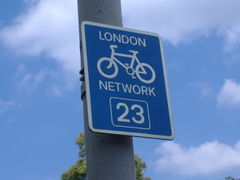More complex cycle routes
Jump to navigation
Jump to search

|
| Description |
| Bicycle and cycleway features |
| Group |
| Tags |
|
This is a proposal for mapping of more complex cycle routes:
- The route could be very long, spanning regions or even countries (for this situation superroute relations are already in use)
- There could be different modes of transport along the route. A stretch a train ride, a funicular or specialised bus services.
- In the case of ferries it's up to the mapper to decide if it merits splitting in separate route relations for the sections.
- It could happen that some stretches are planned, but will take a few more years before they will be realised, and the mapper wants to show the proposed situation as well as detours necessary today.
- The bicycle route relation might share long stretches with other bicycle route relations, DRY principle (don't repeat yourself)
Tagging cycle superroute networks
An example cycle superroute relation has the following tags:
| Tag | Comment |
|---|---|
| type=superroute | |
| route=bicycle/mtb | See mountainbike for details on tagging mountainbike routes. |
| network=icn/ncn/rcn/lcn | Specify the network as an international route, a national route, a regional route, or a local route, as per the normal tagging of cycle routes. For tagging mountainbike routes more specific look here mountainbike |
| cycle_network=* | (optional) In countries that have (for instance) multiple regional route networks, this tag indicates the specific route system, much the way network=* does on road route relations. |
| ref=number | (optional) NCN, RCN, and LCN references work best on the map if just the number is used, so for NCN 4: "4". The network or cycle_network tag correctly distinguishes the type, so just use "ref" and not "ncn_ref" or similar. |
| name=* | (optional) The name of the route e.g. Jubilee Cycle Way |
| state=proposed | (optional) Routes are sometimes not official routes pending some negotiation or development -- the opencyclemap rendering shows these routes dotted. |
| distance=distance in km | (optional) The distance covered by a route in km |
| ascent=ascent in m | (optional) The ascent covered by a route in meters. If a route has start and end point at different altitude use descent too |
| descent=descent in m | (optional) The descent covered by a route in meters. Use it only if it differs from the ascent (different altitude at start/endpoint of a route). |
| roundtrip=yes/no | (optional) Use roundtrip=no to indicate that a route goes from A to B. Use roundtrip=yes to indicate that the start and finish of the route are at the same location (circular route). |
| colour=* | (optional) To indicate the official colour associated with a route. In the Waymarked Trails cycling map, the displayed ref/name of a route gets underlined in this colour (example). |
Relation role: Use the following roles for the route relations referred to in the superroute:
- transfer
- transfer_on_foot
- transfer_by_train
- transfer_by_ferry
- transfer_by_funicular
I would prefer to see the more specific roles in the superroute relation.
The relation that describes the train part would use the conventions for mapping public transport. If there is a fee, I don't know if it would be better to add it to the superroute or to the route relation. It may also depend on whether the fee is different with or without a bicycle, or depending on whether one is doing that itinerary.